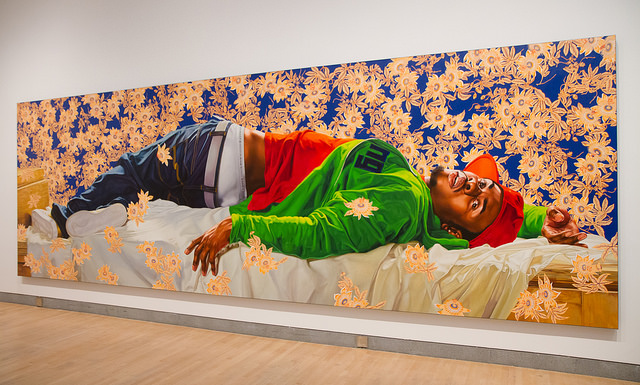
The magic of visual art lies in its ability to communicate in ways not possible through words. Much like music, art is a universal language that can rise above cultural barriers. African-American art, specifically, is full of examples of this transcendence. Art in the black community has been used to exorcise pain, to rejoice and to record life. From artists like the silhouette artist, Kara Walker, or the painter, Jacob Lawrence, we can learn history not always taught in our schools. Art gives us a window into lives that may be different from our own or reveal how similar we all are when preconceived notions are stripped away.
Aesthetically, I gravitate towards art that is full of rich colors, bold shapes and dynamic compositions. There is a bounty of African-American art, in a variety of media, that fits this bill.
African-American women, like so many women in history, expressed themselves through beautiful textile arts. One difference is explored in “Hidden in Plain View: A Secret Story of Quilts and the Underground Railroad”; Jacqueline Tobin tells how quilt patterns were used to give encoded messages to men and women traveling on the Underground Railroad. Another selection, “The Quilts of Gee’s Bend” displays the talent of the women of Gee’s Bend, Alabama, who have upheld a tradition of lively quilt-making through the generations going back two hundred years. I love these!
For a modern take, see the art of Faith Ringgold. The DVD “Romare Bearden Visual Jazz; Faith Ringgold: the Last Story Quilt” is in the DBRL collection. Romare Bearden worked in different mediums but may be best known for his work in collage. Like quilts made of paper, his collages were pieced together to form a whole using scraps cut out of magazines. His work from the 1960s was a reflection on the Civil Rights Movement in an effort towards making more socially conscious art. In 1987, he was awarded the National Medal of Arts.
From post-WWI through the early 1930s, Harlem became a gathering place for black artists, poets and musicians. A leading artist in the Harlem Renaissance was Topeka-born Aaron Douglas. He combined a love for African art with an interest in modernism, resulting in bold graphics which tell tales of black life in America. Using diagonal lines and concentric circles, he brought to his work the energy of African-American struggle, as well as celebrations of joy.

Present day African-American artists whose work I enjoy include portrait artists Kehinde Wiley, Mickalene Thomas and Barkley L. Hendricks. Each gives a modern spin to this traditional art form. Kehinde Wiley may be the most well-known. In April 2013, GQ magazine ran an article about him entitled Kehinde the First. From GQ:
At 36, he is already one of the art world’s brightest lights, painter of portraits that borrow heavily from the old to make something blazingly new. Where once there were only white kings and their queens, Kehinde Wiley inserts the “brown faces” long absent from Western art. Rappers, athletes, kids off the street.
 Columbia is privileged to have many talented artists. Two of my favorites are Kenneth Greene and Byron Smith. Greene is currently featured in an article about local jewelry artists in COMO Living magazine’s February/March issue, as well as a show at Orr Street Studios. Smith paints plein air (meaning in the open air) images of landscapes. The library has one of his paintings of the Blind Boone Home in our collection.
Columbia is privileged to have many talented artists. Two of my favorites are Kenneth Greene and Byron Smith. Greene is currently featured in an article about local jewelry artists in COMO Living magazine’s February/March issue, as well as a show at Orr Street Studios. Smith paints plein air (meaning in the open air) images of landscapes. The library has one of his paintings of the Blind Boone Home in our collection.
Please explore our collection of books and DVDs to get a full appreciation of the wealth of beauty gifted to us from the African-American artist community. You’ll be glad you did!

image credits: rocor, Kara Walker via Flickr (license); Garrett Ziegler, Kehinde Wiley, A New Republic, Brooklyn Museum via Flickr (license); Bosc d’Anjou, Untitled via Flickr (license)


